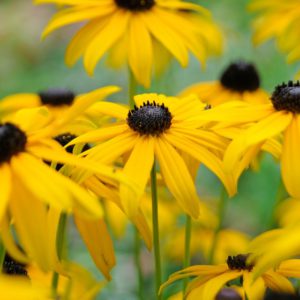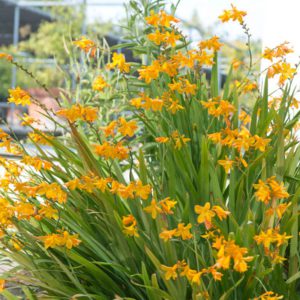Nepeta ‘Persian Blue’
€8.50
Frequently Bought Together


Description
Quick Facts
- Common Name: Persian Blue Catmint, Persian Blue Catnip
- Botanical Name: Nepeta ‘Persian Blue’
- Plant Type: Herbaceous perennial
- Mature Height: 40-60cm
- Mature Spread: 40-50cm
- Flowering Period: June to September (long flowering season)
- Flower Colour: Rich violet-blue flowers
- Foliage: Aromatic grey-green leaves, semi-evergreen
- Hardiness: RHS H5 (hardy in most of UK and Ireland)
- Soil Requirements: Well-drained soil; tolerates poor and dry soils
- Aspect: Full sun to partial shade
- Maintenance: Low
Description
Experience the breathtaking beauty of Nepeta ‘Persian Blue’, one of the most spectacular and floriferous catmints for gardens, where masses of rich violet-blue flowers create billowing clouds of colour from early summer through autumn, transforming borders into romantic displays of blue haze that attract countless pollinators and bring cottage garden charm with exceptional reliability and effortless elegance. This exceptional cultivar offers remarkable qualities—profuse masses of rich violet-blue tubular flowers arranged in dense spikes covering the plant from June through September creating months of continuous colour and non-stop pollinator attraction, aromatic grey-green foliage with minty fragrance released when brushed or crushed bringing sensory delight and deer-resistant qualities, compact mounding habit forming neat billowing clumps that soften border edges and create informal romantic presence without flopping or requiring staking, exceptional drought tolerance and adaptability thriving in poor dry soils, gravel gardens, and challenging conditions where many perennials struggle, and outstanding pollinator value attracting bees, butterflies, and beneficial insects throughout the long flowering season, making this one of the most rewarding and versatile choices for adding long-lasting blue flowers, aromatic foliage, and pollinator-friendly planting to borders, gravel gardens, cottage gardens, and anywhere effortless summer colour with romantic cottage charm is desired.
Throughout the seasons, this captivating perennial displays its most spectacular features from early summer through autumn—the flowering begins in June when masses of rich violet-blue tubular flowers emerge in dense terminal spikes rising above the foliage, each spike measuring 10-15cm long and packed with individual flowers creating substantial colour impact. The flowers are two-lipped tubular blooms typical of the mint family, each measuring approximately 1cm long, in beautiful shades of rich violet-blue to lavender-blue creating cool romantic colour that complements virtually every other garden colour. The flowers are arranged in whorls along the spikes creating textured appearance and maximum visual impact. Flowering continues prolifically through summer and into early autumn (June-September), with deadheading encouraging continuous flower production and extending the display. The overall effect during flowering is like billowing clouds or soft haze of violet-blue creating romantic cottage garden atmosphere. The foliage is equally attractive—aromatic grey-green leaves measuring 3-5cm long with slightly toothed edges and soft texture creating neat mounds of foliage that remain attractive even when not in flower. The leaves release delightful minty-herbal fragrance when brushed or crushed, adding sensory dimension to the garden. The growth habit is compact and mounding, forming neat clumps that spread gradually to create substantial presence without becoming invasive—the stems are sturdy and self-supporting, maintaining neat form without flopping or requiring staking unlike some taller catmints. In mild winters, the foliage remains semi-evergreen providing year-round presence, though in colder areas it may die back and re-emerge in spring. The overall effect throughout the growing season is romantic, billowing, and effortlessly elegant—like having clouds of blue flowers floating through the garden.
Nepeta is a genus of approximately 250 species native to Europe, Asia, and North Africa, with many species and cultivars grown for their attractive flowers, aromatic foliage, and pollinator value. The common name “catmint” or “catnip” refers to the plant’s attraction to cats, which are drawn to the aromatic compounds in the foliage (though ‘Persian Blue’ is less attractive to cats than true catnip Nepeta cataria). The genus name Nepeta is derived from the ancient Etruscan city of Nepete (modern Nepi in Italy) where catmints grew abundantly. ‘Persian Blue’ is a superior modern cultivar selected specifically for its rich violet-blue flower colour, compact habit, long flowering season, and exceptional garden performance—it represents a significant improvement over older catmint varieties with more intense colour, neater habit, and longer flowering. Hardy to RHS H5, this robust perennial thrives reliably in most areas with minimal care, tolerating cold winters, drought, poor soils, and challenging conditions. Fast growth rate, establishing quickly and reaching full size within 1-2 years, flowering reliably in first season. Particularly valuable for exceptionally long flowering season providing months of continuous colour from early summer through autumn, outstanding drought tolerance once established making it perfect for low-maintenance and gravel gardens, excellent pollinator value attracting bees and butterflies throughout summer, and deer and rabbit resistance due to aromatic foliage. The compact mounding habit and self-supporting stems make this easier to manage than taller floppy catmints.
Create stunning compositions by planting in drifts or groups of 3-5 plants in mixed borders where the billowing violet-blue flowers create romantic cottage garden atmosphere and soften hard edges, using as edging along paths, patios, or border fronts where the compact habit and aromatic foliage can be appreciated up close and brushed to release fragrance, or positioning in gravel gardens and Mediterranean-style plantings where the drought tolerance and informal habit excel. Exceptional in cottage gardens combined with traditional perennials (roses, lavender, geraniums, salvias) creating classic romantic plantings, pollinator gardens where the long flowering season and nectar-rich flowers provide essential food source for bees and butterflies, or contemporary gardens where the soft blue colour and billowing form create naturalistic drifts and prairie-style plantings. Works beautifully planted in generous groups or drifts for maximum colour impact—single plants are attractive but massed plantings create spectacular blue clouds, combined with contrasting colours—yellow flowers (Achillea, Coreopsis, Hemerocallis) for complementary colour schemes, pink flowers (Echinacea, Penstemon, Salvia) for harmonious romantic combinations, or white flowers (Gaura, Leucanthemum, Nepeta ‘Snowflake’) for cool elegant plantings. Also magnificent combined with ornamental grasses (Stipa, Calamagrostis, Pennisetum) that provide contrasting texture and movement, silver-leaved plants (Artemisia, Stachys, Santolina) that echo the grey-green foliage, or roses where the catmint softens the base of rose bushes and provides continuous colour between rose flushes—a classic combination! Perfect for adding long-lasting blue flowers, aromatic foliage, and pollinator-friendly planting to borders, gravel gardens, cottage gardens, and anywhere effortless summer colour with romantic cottage charm is desired.
Caragh Garden Notebook
Planting: Space plants 40-50cm apart for individual specimens that will form neat mounds, or 30-40cm apart for quicker coverage and merged drifts. Plant container-grown specimens year-round, though spring (March-May) or autumn (September-October) is ideal for best establishment. Choose position in full sun for most prolific flowering—tolerates partial shade but flowering may be reduced and habit may be slightly more open. Thrives in well-drained positions including poor soils, gravel gardens, and dry banks—avoid rich fertile soils which cause soft floppy growth. Dig planting hole slightly larger than root ball. This plant thrives in lean conditions, so minimal soil improvement is needed—avoid adding compost or fertiliser which encourages lush growth prone to flopping. Plant at same depth as in container. Backfill with excavated soil, firming gently. Water thoroughly after planting. Mulch lightly with gravel or grit rather than organic mulch—gravel mulch improves drainage around crown, reflects light and heat promoting flowering, and suits the plant’s preference for lean dry conditions. Water regularly during first growing season to establish root system, though established plants are remarkably drought-tolerant. Position where the billowing blue flowers and aromatic foliage can be appreciated and where plants have room to form attractive mounds.
Soil Preparation: Tolerates wide range of soil types including clay, loam, sandy, chalky, and poor soils—this is one of the most adaptable perennials for challenging conditions. Prefers neutral to alkaline pH (6.5-8.0) but tolerates slightly acidic conditions. CRITICAL: Requires well-drained soil—avoid waterlogged or heavy wet soils which cause root rot and poor performance, particularly in winter. Thrives in poor to moderately fertile soils—rich fertile soils cause soft lush growth that flops and requires staking, so lean conditions are preferred. Excellent for dry sunny banks, gravel gardens, and Mediterranean-style plantings where drainage is excellent and fertility is low. Improve heavy clay soils by incorporating grit or gravel to improve drainage—avoid adding organic matter which increases fertility. Light sandy soils are ideal and require no improvement. Once established, this plant is remarkably drought-tolerant and thrives in dry conditions. Avoid mulching with organic matter (compost, bark) which retains moisture around crown—use gravel or grit mulch instead, or leave unmulched. Best growth and flowering occur in full sun with well-drained, lean to moderately fertile soil—these conditions produce compact sturdy growth and profuse flowering.
Container Growing: Excellent for container growing! Use free-draining compost (mix soil-based compost with extra grit or perlite for improved drainage), choose containers with drainage holes, and position in full sun. Water regularly during growing season allowing compost to dry slightly between waterings—avoid overwatering which causes root rot. Feed sparingly with half-strength balanced liquid fertiliser once or twice during growing season—avoid overfeeding which causes lush floppy growth. Deadhead regularly to prolong flowering. Perfect for patio containers, window boxes, and grouped container displays where the aromatic foliage can be appreciated up close.
Seasonal Care: Deadhead regularly throughout flowering season (June-September) to prolong flowering and maintain neat appearance—remove spent flower spikes by cutting back to just above foliage level, which encourages fresh flowers and extends display. After main flowering flush in midsummer (typically July), shear back entire plant by one-third to one-half to encourage fresh foliage growth and second flush of flowers in late summer and autumn—this “Chelsea chop” technique keeps plants compact and promotes continuous flowering. In late autumn or early spring (October-November or March), cut back all stems to ground level (5-10cm) to tidy plant and encourage vigorous fresh growth—in mild areas with semi-evergreen foliage, this can be delayed until early spring. Apply light dressing of general-purpose fertiliser or blood, fish and bone in spring if desired, though this plant thrives in lean conditions and rarely needs feeding—avoid overfeeding. Water during prolonged drought in first year, though established plants are remarkably drought-tolerant and rarely need watering. Generally pest and disease free—the aromatic foliage deters most pests and the plant has excellent disease resistance. Deer and rabbit resistant due to aromatic foliage. The long flowering season and continuous colour are reliably spectacular!
Division: Divide every 3-4 years to maintain vigour and flowering performance, or to propagate new plants. Best divided in spring (March-April) as new growth emerges, or in early autumn (September). Lift entire clump carefully with fork, divide into sections ensuring each has roots and shoots, replant divisions immediately at same depth, water thoroughly, and keep watered until established. Divisions establish quickly and flower in first season. Can also be propagated from softwood cuttings taken in late spring (May-June)—take 5-8cm cuttings from non-flowering shoots, remove lower leaves, insert into free-draining compost, and roots develop within 3-4 weeks.
This spectacular beauty is absolutely breathtaking—one of the most floriferous and reliable catmints available! Those profuse masses of rich violet-blue flowers creating billowing clouds of colour from June through September are absolutely stunning—months of continuous colour and non-stop pollinator attraction! Aromatic grey-green foliage with delightful minty fragrance, compact mounding habit forming neat clumps without flopping or staking, exceptional drought tolerance thriving in poor dry soils and challenging conditions. Outstanding pollinator value—attracts bees and butterflies throughout summer! Deer and rabbit resistant. Hardy (RHS H5) in most areas—completely reliable! Deadhead regularly and shear back after main flush for continuous flowering. Perfect for borders, gravel gardens, cottage gardens, path edging, pollinator gardens, and anywhere you want long-lasting blue flowers with romantic cottage charm and effortless elegance. Excellent in containers! Pure cottage garden magnificence and billowing blue beauty!





